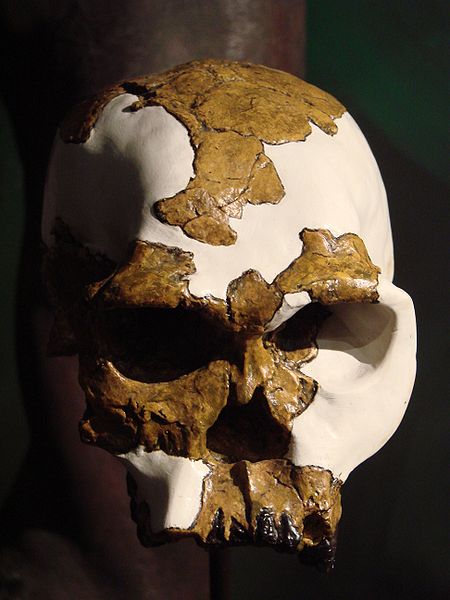The Evolution of Man
No topic is more controversial in religious circles than the evolution of man. Evolution is controversial enough by itself, but when we start saying that man himself evolved from lower animals … well, look out!
I hope that this quote by C.S. Lewis and some of my own explanation will help those of you with doctrinal difficulties with human evolution. Remember, I'm a Christian! I believe in the fall of man!
However, on the scientific side …
Evidence for the Evolution of Man
 Homo habilis, the first species of the genus Homo
Homo habilis, the first species of the genus HomoThe evidence for the evolution of man is more than fossils and missing links. There is an amazing pattern to the fossils that have been found, and I hope to bring that out in this section.
From the human evolution timeline we can pull an amazing lineage. That this series is some sort of accident—by a stroke of luck as numerous errors fell together into a continuous series of dates, events, and locations—is rather hard to believe, don't you think?
- Pierolapithecus catalaunicus – This 11.9 million-year-old fossil may represent what the public considers "the missing link," though that term is inaccurate. Scientists are hoping that this is the last common ancestor of apes and humans. As you can see below, the chain of human evolution has many links that are not missing, and they give clues to links, plural, that are missing.
- Sahelanthropus tchadensis – This creature, dated between 6 and 7 million years ago (mya), had a cranial capacity (brain size) of 350 cc and was found in Chad in central Africa. With similarities to both chimps and humans, it was unlikely to have been bipedal (walked on two feet)
- Ardipithecus ramidus – (All new information as of 10/2/2009!) This forest dweller had the brain-size of a chimp (400 cc), small canines, and was bipedal! It changed some ideas about the evolution of man! It was found in Ethiopia, not far from Chad in central Africa.
- Australopithecus anamensis – This creature also had an unknown cranial capacity. It lived about 4 mya, and it had thick enamel on its teeth, one of the marks of human lineage. It was found in Kenya, just south of Ethiopia.
- Australopithecus afarensis – Many fossils of this link—no longer missing—in the evolution of man have been found. It lived from 3.9 to 2.9 mya. Its cranial capacity was up to 500 cc. It's teeth are more human-like than the previous creatures, and its jaw is beginning to have the human parabolic shape. Its fossils, as well as footprints—fully establishing its bipedality—have been found in Ethiopia, Cameroon, and Tanzania.
- Australopithecus africanus – Similar to afarensis in brain size, its jaw has a fully human shape. It was found in South Africa and dates from 2 to 3 mya. This line almost certainly died out.
- Homo habilis – Homo habilis lived from 2.4 to 1.5 mya and had a primitive-looking, flat face with a sloping brow and no chin, like the australopithecines, but its teeth are smaller and more human-like. Its brain was shaped like a human brain and averaged 650 cc in size. It, like robustus and boisei has been found in Kenya and Tanzania.
- Homo georgicus – These hominids, intermediate between habilis and erectus, were discovered in Dminisi, Georgia, making them the first hominids out of Africa ... possibly. Now there's questions about the 2003 discovery of ...
- Homo floresiensis – Dubbed "hobbits" because of their dimunitive size, these fossils were found on the island of Flores in Indonesia. Studies of brain size make it seem these are descendants of habilis, georgicus, or an unknown species, and they possibly emigrated from Africa. That would be stunning with their chimpanzee-sized brains. They've probably been in Indonesia for at least 1 million years and only went extinct 17,000 years ago.
- Homo erectus – This is the species that first left Africa. It lived from 1.8 mya to 300,000 years ago. In early fossils, its brain size averages 900 cc. A million years later, the skulls have an average cranial capacity of 1100 cc. It had a small forehead and still no chin, but it probably walked better than we do. We have larger pelvises to accomodate the birth of large-brained babies.
- Homo ergaster and heidelbergensis – These are likely just the African and European races of Homo erectus. They vary like human races vary, only in height and robustness, though later fossils of heidelbergensis are difficult to distinguish from early Homo sapiens.
- Denisovans – Denisovans are known only from DNA extracted from a finger bone and a molar found in Denisova cave in Siberia. Thus, all there are no morphological data on the Denisovans. Humans carry DNA from denisova, thus indicating that they will not be classified as a separate species, but simply a population of archaic humans. Their DNA is primarily found in Melanesians, indicating a possible ancestral mix in southeast Asia. Their role in the evolution of man is much debated. Work is still being done in the Denisova cave, and progress in news of this find has been rapid.
- Homo neandethalensis – Neanderthals (now usually Neandertals) have been found only in Europe and the Middle East. They are a side branch in the evolution of man and died out about 30,000 years ago. They were shorter than Homo sapiens with bigger brains (1450 cc) and much stronger bodies. Scientists say their adaptations are typical for cold weather. Recent DNA studies have established that Neanderthals intermingled with humans. Many humans carry Neandertal DNA, especially outside of Africa.
- Homo sapiens – This is us. Our average cranial capacity is about 1300 cc, and we have much more upright foreheads and pronounced chins than Homo erectus (except some of the later European versions).
I hope you can see how hard it is to ignore this series of evolution of man fossils, most of them very well attested.
The Progression in the Evolution of Man
 Davy Crockett State Park in Lawrenceburg, TN
Davy Crockett State Park in Lawrenceburg, TNWe begin 6 to 7 million years ago in central Africa with a creature much like a chimpanzee, except that its canines are smaller. From there we find progressive adaptations in teeth moving closer and closer to humans, while cranial capacity increases smoothly. The knees, tibia, feet, and toes become more and more adapted to walking and less and less adapted to climbing.
The recent release of the results of the study of Ardipithecus ramidus fossils has shed much light on the evolution of man. Habitual bipedality is now driven back to 4.4 million years ago, and knuckle walking was not a halfway measure between walking on four legs and walking on two. Instead, it evolved separately on the ape line.
The ape line, by the way, is a separate line of primates, not ape to human evolution.
Then, somewhere around 1.5 million years ago some Homo erecti left Africa. They spread throughout Europe and Asia, growing larger in brain capacity, and their faces becoming more and more human until about 195,000 years ago the first fully anatomical humans appear.
Finally around 35,000 or 40,000 years ago, these humans began to show behavior typical of modern humans, making art, burying their dead, and performing ceremonies.
Even over the last 20,000 years, we still find that human teeth size and bone structure is still becoming progressively smaller.
It's hard to ignore this progression or to pretend like it is not evolution of man from some primate that was the ancestor of both apes and man.
C.S. Lewis' Comment on the Evolution of Man
For Christians that struggle with the idea of the evolution of man, I have two comments to help. One, even evolutionary history suggests that there was a time that God breathed a living soul into primitive man.
For the second comment I turn to C.S. Lewis, famed author of The Chronicles of Narnia and Mere Christianity and one of the most respected Christian thinkers of the 20th century.
For long centuries, God perfected the animal form which was to become the vehicle of humanity and the image of Himself. He gave it hands whose thumbs could be applied to each of the fingers, and jaws and teeth and throat capable of articulation, and a brain sufficiently complex to execute all of the material motions whereby rational thought is incarnated.
The creature may have existed in this stage for ages before it became man: it may have even been clever enough to make things which a clever archaeologist would accept as proof of its humanity. But it was only an animal because all its physical and psychical processes where directed to purely material and natural ends.
Then in fullness of time, God caused to descend upon this organism, both on its psychology and physiology, a new kind of consciousness which could say "I" and "me," which could look upon itself as an object, which knew God, which could make judgments of truth, beauty, and goodness, and which was so far above time that is could perceive time flowing past. …
We do not know how many of these creatures God made, nor how long they continued in the Paradisal state. But sooner or later they fell. Someone or something whispered that they could become as gods …
– C.S. Lewis, The Problem of Pain
paragraph breaks and emphasis added